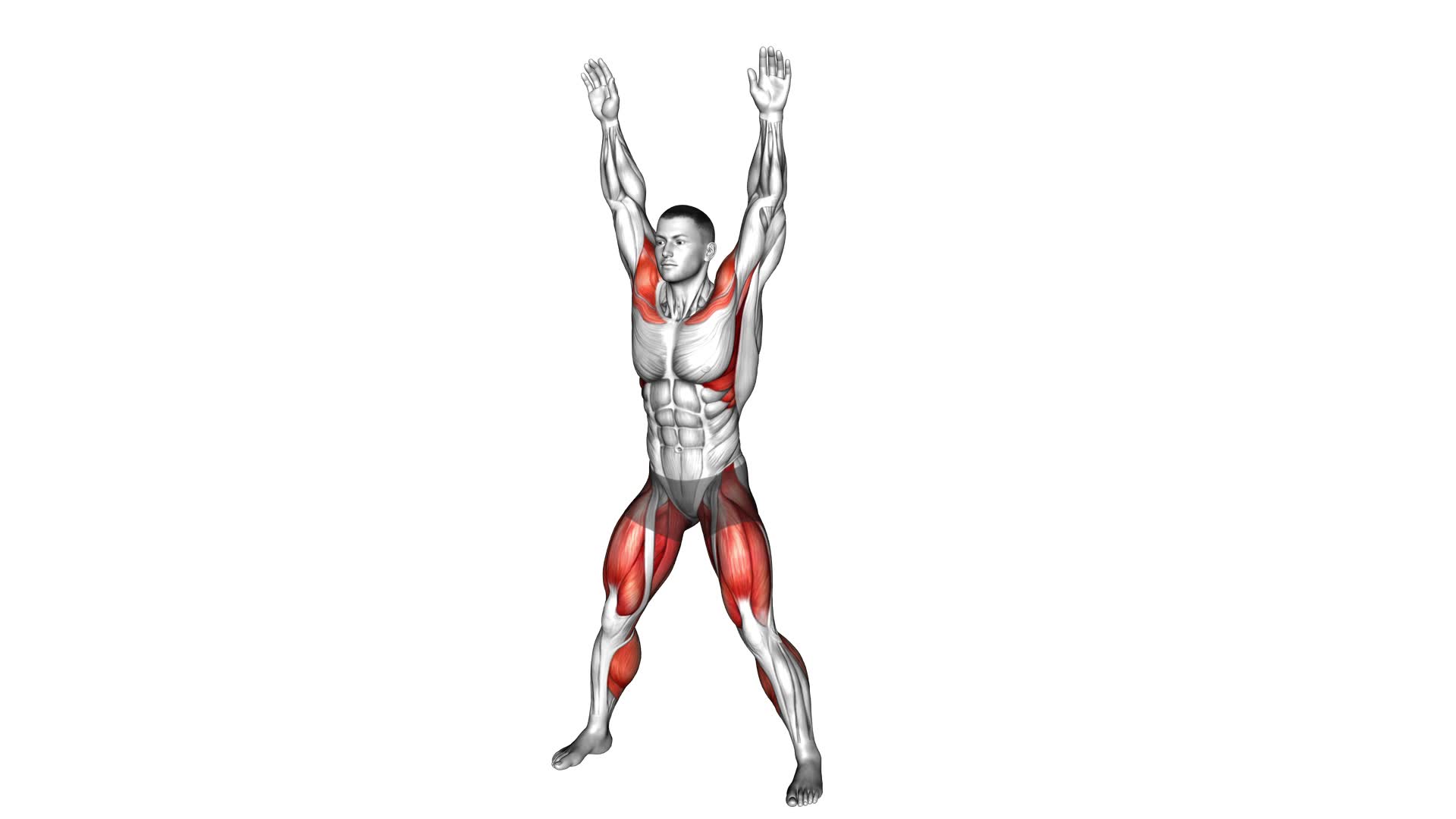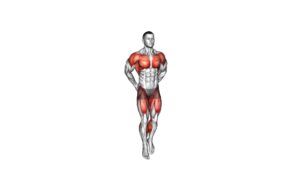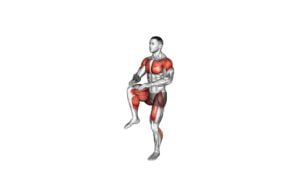Jumping Squat Jack (male) – Video Exercise Guide & Tips

Looking to amp up your workout routine? Check out this video exercise guide and tips for the Jumping Squat Jack, designed specifically for male athletes.
Watch This Exercise Video
This high-intensity move targets multiple muscle groups, helping you build strength and improve aerobic capacity.
Whether you're a beginner or an experienced athlete, we've got you covered with modifications and advanced variations.
Avoid common mistakes and maximize your results with these expert tips.
Get ready to jump, squat, and jack your way to fitness!
Key Takeaways
- Jumping Squat Jacks target multiple muscle groups, including legs, glutes, core, and shoulders.
- Jumping Squat Jacks improve cardiovascular health and endurance.
- Jumping Squat Jacks build muscular strength and enhance athletic performance.
- Jumping Squat Jacks provide a full-body workout.
Benefits of Jumping Squat Jacks
Get ready to experience the amazing benefits of the Jumping Squat Jacks as it strengthens your entire body and improves your cardiovascular fitness. Jumping Squat Jacks are a type of plyometric exercise that combines the movements of a squat and a jumping jack.
This exercise targets multiple muscle groups, including your legs, glutes, core, and shoulders, making it a highly effective full-body workout.
One of the main benefits of Jumping Squat Jacks is their ability to increase your cardiovascular health. By incorporating explosive movements and quick transitions, these plyometric exercises elevate your heart rate and improve your cardiovascular endurance. This means that over time, you'll be able to perform physical activities for longer periods without feeling fatigued.
Additionally, Jumping Squat Jacks help to improve your overall strength and power. The squatting motion engages your lower body muscles, such as your quadriceps, hamstrings, and calves, while the jumping jack movement targets your shoulders and core. By regularly including Jumping Squat Jacks in your workout routine, you can build muscular strength and enhance your athletic performance.
Proper Form and Technique
To ensure proper form and technique during Jumping Squat Jacks, focus on maintaining a stable and controlled movement throughout the exercise. This won't only help you maximize the benefits of the exercise but also minimize the risk of injury. One of the most common mistakes people make is rushing through the movement, sacrificing control for speed. Remember, it's important to perform each repetition with intention and precision.
Start by standing with your feet shoulder-width apart and your arms extended in front of you. As you lower into a squat, make sure to keep your knees in line with your toes and your back straight. Then, explode upwards, jumping into the air while simultaneously spreading your legs out to the sides and raising your arms overhead. Land softly and immediately go into the next repetition.
Before starting any intense exercise like Jumping Squat Jacks, it's crucial to warm up properly. A good warm-up will increase your heart rate, improve blood flow to your muscles, and enhance your range of motion. This can help prevent injuries and prepare your body for the demands of the exercise.
Now that you understand the importance of proper form and warm-up, let's move on to modifications for beginners.
Modifications for Beginners
To modify Jumping Squat Jacks for beginners, start by performing the exercise at a slower pace and with less intensity. This will help you build strength and endurance gradually, while reducing the risk of injury. Focus on maintaining proper form throughout the exercise. Keep your feet shoulder-width apart and your knees aligned with your toes. As you jump, extend your arms overhead and land softly on the balls of your feet.
To further modify the exercise, you can perform a modified version called the Squat Jack. Instead of jumping, step your feet out to the side and then back in, while keeping your upper body still. This will still engage your lower body muscles and provide a good cardiovascular workout. Remember to listen to your body and take breaks as needed.
As you gain strength and confidence, you can gradually increase the speed and intensity of the exercise.
Now that you have learned how to modify Jumping Squat Jacks for beginners, let's explore some advanced variations for experienced athletes.
Advanced Variations for Experienced Athletes
Now that you've mastered the basic jumping squat jack, it's time to take your workout to the next level with advanced variations for experienced athletes.
These modifications are designed for elite athletes who are looking to challenge themselves and push their limits.
Incorporating next-level training techniques will help you continue to build strength, power, and endurance, taking your fitness journey to new heights.
Elite Athlete Modifications
For experienced athletes seeking advanced variations, try incorporating elite athlete modifications into your Jumping Squat Jack routine. These modifications are designed to enhance athlete performance and prevent injuries.
One modification you can try is adding resistance to your Jumping Squat Jacks by holding dumbbells or wearing a weighted vest. This will increase the intensity of the exercise and challenge your muscles even more.
Another modification is to perform the exercise on an unstable surface, such as a Bosu ball or a balance board. This will engage your core muscles and improve your balance and stability.
Additionally, you can also try performing the exercise at a faster pace or increasing the height of your jumps.
Remember to always listen to your body and consult with a fitness professional before attempting any advanced variations.
Next-Level Training Techniques
Take your training to the next level with advanced variations designed specifically for experienced athletes. These next-level training techniques will help you push your limits and enhance your performance.
Here are four plyometric exercises that focus on explosive power training:
- Depth Jumps: Start from an elevated platform and jump down, immediately exploding into a vertical jump as soon as your feet touch the ground.
- Box Jumps with Resistance Bands: Attach resistance bands to your waist and perform box jumps, adding an extra challenge to your explosive power training.
- Medicine Ball Throws: Incorporate medicine ball throws into your routine, focusing on explosive movements to maximize power and strength.
- Plyometric Push-Ups: Perform push-ups with an explosive push-off at the top, aiming to generate maximum power with each repetition.
These advanced variations will help experienced athletes take their training to the next level, improving their explosive power and overall athletic performance.
Common Mistakes to Avoid
When performing the jumping squat jack, it's important to avoid common mistakes to ensure safety and effectiveness. Incorrect form can lead to injuries, so make sure to maintain proper alignment and technique throughout the exercise.
Additionally, skipping a warm-up can increase the risk of muscle strains or pulls, so take the time to prepare your body before jumping into the workout.
Lastly, be mindful of overtraining, as pushing yourself too hard without proper rest and recovery can lead to fatigue and potential injury.
Incorrect Form Dangers
To avoid potential injuries, it's important that you pay close attention to your form while performing the Jumping Squat Jack exercise. Incorrect form can lead to serious risks and consequences that may hinder your progress and cause harm to your body.
Here are some common mistakes to avoid:
- Landing with locked knees: This puts excessive strain on your joints and can lead to knee injuries.
- Arching your back: This not only reduces the effectiveness of the exercise but also puts unnecessary stress on your lower back.
- Allowing your knees to buckle inward: This places undue pressure on your knee joints and increases the risk of injury.
- Not engaging your core: Without proper core activation, you may experience lower back pain and instability during the exercise.
Lack of Warm-Up
Make sure you warm up before performing the Jumping Squat Jack exercise to avoid common mistakes and potential injuries. A proper warm-up routine is essential for injury prevention and optimal performance during any exercise.
By taking a few minutes to prepare your body, you can increase blood flow to your muscles, improve flexibility, and reduce the risk of strains or sprains. Start with some light aerobic exercises like jogging or jumping jacks to raise your heart rate and warm up your muscles.
Then, incorporate dynamic stretches that target the muscles you'll be using in the Jumping Squat Jack, such as lunges or leg swings.
Overtraining Risks
To avoid overtraining risks, ensure you listen to your body and give yourself enough time to rest and recover between Jumping Squat Jack workouts. Overtraining can have serious consequences on your overall fitness and wellbeing, so it's crucial to be aware of the signs and take necessary precautions.
Here are some common mistakes to avoid:
- Ignoring fatigue and pushing through extreme exhaustion
- Failing to incorporate rest days into your workout routine
- Neglecting proper nutrition and hydration
- Not allowing your muscles enough time to recover and rebuild
Overtraining can lead to decreased performance, increased risk of injury, chronic fatigue, and even mental health issues. By recognizing the signs of overtraining and implementing adequate rest and recovery strategies, you can prevent these negative consequences and maximize your results.
Now let's explore some tips for maximizing your Jumping Squat Jack workouts.
Tips for Maximizing Results
Maximize your results by incorporating these key tips into your Jumping Squat Jack workout. When it comes to maximizing your results, it's important to address common misconceptions and focus on nutrition for optimal results.
One common misconception is that doing more repetitions will lead to better results. While it's true that increasing the intensity of your workout can help you achieve better results, doing too many repetitions can lead to overtraining and potential injuries. It's important to find the right balance and listen to your body.
Another important aspect to consider is nutrition. To get the most out of your Jumping Squat Jack workout, it's essential to fuel your body properly. Make sure to eat a balanced diet that includes lean protein, complex carbohydrates, and healthy fats. Stay hydrated and consider incorporating pre and post-workout snacks to support your body's needs.
Additionally, it's important to give your body enough time to rest and recover. Overtraining can hinder your progress and increase the risk of injuries. Incorporate rest days into your workout routine and prioritize quality sleep to allow your muscles to repair and grow.
Frequently Asked Questions
How Many Calories Can I Expect to Burn While Doing Jumping Squat Jacks?
When you're doing jumping squat jacks, you're not only getting a great workout, but you're also burning calories. The number of calories burned can vary depending on factors such as your weight, intensity, and duration of the exercise. However, on average, you can expect to burn around 8-12 calories per minute while doing jumping squat jacks.
In addition to burning calories, this exercise also helps improve your vertical jump, making it a great addition to your fitness routine.
Can Jumping Squat Jacks Help Improve My Vertical Jump?
Jumping squat jacks are a great exercise for improving your vertical jump. Incorporating plyometric exercises like this into your vertical jump training can yield significant benefits.
By combining the explosive power of a squat jump with the agility of a jumping jack, you're targeting the muscles needed for an explosive jump.
This exercise helps improve your lower body strength, power, and coordination, all of which are essential for an impressive vertical jump.
Are There Any Specific Breathing Techniques I Should Use While Performing Jumping Squat Jacks?
When performing jumping squat jacks, it's important to focus on your breathing techniques and maintain proper form.
By controlling your breath, you can optimize your performance and prevent fatigue. Make sure to inhale deeply through your nose before starting the exercise and exhale forcefully through your mouth as you jump and squat.
This will help you engage your core and maintain stability throughout the movement. Remember to always prioritize safety and listen to your body.
Can I Incorporate Jumping Squat Jacks Into My Regular Cardio Routine?
Yes, you can definitely incorporate jumping squat jacks into your regular cardio routine. They're a great exercise for weight loss as they target multiple muscle groups and increase your heart rate.
To modify for beginners, you can start by doing regular squat jacks without the jumping motion. As you get stronger and more comfortable, you can gradually add in the jumping movement.
Remember to listen to your body and take breaks when needed.
How Often Should I Include Jumping Squat Jacks in My Workout Routine to See Results?
To see results from jumping squat jacks, you need to consider the frequency of incorporating them into your workout routine. The effectiveness of this exercise depends on how often you do it.
While there's no one-size-fits-all answer, it's generally recommended to include jumping squat jacks 2-3 times a week. This allows your muscles to recover and adapt to the exercise, leading to improved strength and cardiovascular fitness over time.
Conclusion
Jumping squat jacks are an effective lower body exercise that can help improve strength, power, and cardiovascular fitness. By incorporating proper form and technique, beginners can gradually build their strength while advanced athletes can challenge themselves with variations.
Avoiding common mistakes and following these tips can help maximize results. Incorporate jumping squat jacks into your workout routine for a challenging and effective exercise that targets multiple muscle groups.

Author
Years ago, the spark of my life’s passion ignited in my mind the moment I stepped into the local gym for the first time. The inaugural bead of perspiration, the initial endeavor, the very first surge of endorphins, and a sense of pride that washed over me post-workout marked the beginning of my deep-seated interest in strength sports, fitness, and sports nutrition. This very curiosity blossomed rapidly into a profound fascination, propelling me to earn a Master’s degree in Physical Education from the Academy of Physical Education in Krakow, followed by a Sports Manager diploma from the Jagiellonian University. My journey of growth led me to gain more specialized qualifications, such as being a certified personal trainer with a focus on sports dietetics, a lifeguard, and an instructor for wellness and corrective gymnastics. Theoretical knowledge paired seamlessly with practical experience, reinforcing my belief that the transformation of individuals under my guidance was also a reflection of my personal growth. This belief holds true even today. Each day, I strive to push the boundaries and explore new realms. These realms gently elevate me to greater heights. The unique combination of passion for my field and the continuous quest for growth fuels my drive to break new ground.







